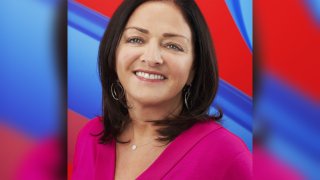Soon, Singapore-based Kacific Broadband Satellites will select the supplier of its second wholesale satellite. Christian Patouraux, the firm’s CEO and founder, says he will then need to raise an estimated US$300 million in debt and equity.
Kacific’s first satellite, Kacific1, was built by Boeing and went into orbit via SpaceX in December 2019. It covers a wide stretch of Asia and the western Pacific, as far south as New Zealand.
The main markets for Kacific1, which cost $227 million, are Papua New Guinea, the Philippines and Indonesia, 70% of users being enterprise and other large organisations, such as schools, healthcare and government, and 30% mobile backhaul. “We connect 300 4G towers in Indonesia,” he says.
But it also provides services to Nepal, and received public attention earlier this year by delivering 1Gbps to Tonga after the archipelago’s subsea cables were destroyed by a volcano, cutting it off from the world.
Patouraux says that Kacific2 – which has a planned service date of late 2025 or early 2026 – will expand his company’s service area by providing 150Gbps of broadband to south and south-east Asia.
The suppliers in the company’s sights are Airbus and Thales of France and Boeing of the US. Both Airbus and Thales have operations in Toulouse, close to where Patouraux was on holiday when I spoke to him. Kacific will make “a soft selection” of one and keep the others on standby in case discussions falter.
Patouraux expects that 60% of the $300 million needed for Kacific2 will come from equity and the remaining 40% from debt. However, he added that the company may order a third satellite – to be Kacific3 – at the same time if it can “secure enough finance”, and that it is developing plans for two more that could see its coverage extend to South America.
Equity and debt
By the time Kacific2 is in service, Patouraux will have been in the satellite industry for 30 years, having joined Luxembourg-based SES after taking a master’s in aerospace at École polytechnique de Bruxelles in Belgium.
He later worked for SES’s O3b unit – this originally stood for “other three billion”, a sign of its target market – as its chief development officer but left to join Measat Satellite Systems in Malaysia.
During this time, Patouraux had what he called “an interesting bicycle ride” in Singapore with a friend, Sebastien Guillaud, co-founder of Hera Capital, which describes itself as “a private equity firm that helps finance and maximize the growth potential of south-east Asia-based companies”. Guillaud agreed to incubate Kacific after Patouraux sent him a deck of 40 slides explaining his idea. And he’s still involved, Patouraux tells me.
In essence, Patouraux wanted to set up a broadband satellite company using a satellite in geosynchronous orbit, that would out-compete and undercut other businesses in south-east Asia’s market. “We went to potential users across the Pacific. By 2017, we had raised $40 million, though that still wasn’t enough.”
But that allowed him to approach Airbus and Boeing with proposals for a satellite. Eventually Kacific raised $227 million in equity and debt, which was enough to build and launch Kacific1 and start the business.
“All the equity came from family offices and private individuals – high net-worth individuals,” says Patouraux. “There was no private equity.”
The debt came from organisations such as Asia Development Bank (ADB), which lent Kacific $50 million in December 2019, just before SpaceX launched Kacific1, in its first satellite financing.
Franchise model
“The idea was to provide broadband at high quality, with a good price point and a high level of access,” says Patouraux. He wanted to use a franchise model, emulating McDonald’s or Starbucks.
“We wanted to go direct to enterprises – small and medium enterprises – but also mines, plantations, the oil and gas industry. And also schools, hospitals and police services, mainly in rural areas.” He believes that the SME segment has been ignored by most operators, he says.
“There’s a feeling that there’s no money there, and that’s wrong,” he says, noting that Indonesia and the Philippines are both “living off primary industries and they are happening in rural areas. If the wealth of these countries comes from rural areas, they need connectivity, they need healthcare, they need education.”
Patouraux adds that he does not see a need for charity or corporate social responsibility (CSR) in funding services. “It doesn’t look sexy, but there’s money for communications,” he says.
Legacy services
Patouraux says the reason why satellite services from Kacific’s rivals cost more is, “We don’t have the weight of legacy [services].” Kacific restricts its services to broadband on the Ka band, the satellite industry’s term for spectrum between 26.5GHz to 40GHz. It avoids other satellite bands – 4GHz to 8GHz, and 18GHz to 27GHz – and shuns services for satellite TV broadcasters, ships and aircraft.
As Patouraux puts it, the company offers “no bells and whistles, just broadband and very little flexibility”. Kacific1 is a geosynchronous satellite, 35,786km above the equator. This offers the advantage that dishes can be left in a fixed position – the same idea used by DirectTV in the US and Sky in the UK. But the disadvantage with two-way geosynchronous services is latency – the time a signal takes to get there and back. But this “doesn’t matter” to Kacific, according to Patouraux.
He acknowledges that, “[Low latency is] important for certain applications – some are more sensitive.”
It is true that some data services require low latency and mobile voice calls can be a challenge without it; especially if both ends are connected via satellite backhaul – that’s four hops, 143,000km in all, and a latency of almost half a second, making rapid-fire conversations all but impossible. Kacific also benefits from having “very stable” mobile backhaul and enterprise contracts, so Patouraux and colleagues can offer its investors good returns.
That takes us to the next satellites in the fleet – Kacific2 and Kacific3.
Patouraux says Kacific’s new satellites “will cover south-east Asia and south Asia” – such as Afghanistan, Bangladesh, India, Pakistan and Sri Lanka. Each will deliver 150Gbps and have 1,000 beams of 150km diameter, so will offer much more precise targeting than Kacific1, which delivers 50-60Gbps and uses 56 600km diameter beams.
Kacific’s founder says that senior debt to fund the new satellites will come from development funds, and the company will also be “looking at vendor finance” and has “initial letters of intent from various providers”. He also suggests that the company has a strong ESG play for many banks.
“If we secure enough finance, we’ll go straight for Kacific3,” Patouraux adds. “I don’t think there’s a market problem. The market is there. It’s waiting for us. And it is waiting for the whole satellite industry to come to its senses. They’re trying to fund their business model, they’re wasting millions, jeopardising the industry. We’re driving prices down, making a huge difference. We are delivering. We are becoming profitable.”
In Patouraux’s view, if Kacific fails to expand its market, “other systems that are more expensive – that means fibre – will take over. If the satellite industry doesn’t come to its senses, fibre will creep in.” If the company orders Kacific2 at the end of this year, it will take three years to get it into service, which means a launch date at the end of 2025 or early 2026.
Middle East and Africa
Kacific is planning to launch three more satellites: Kacific3, Kacific4 and Kacific5. Kacific3 is earmarked to serve parts of Asia and the Middle East, while “Kacific4 will be for the Middle East and Africa,” says Patouraux.
However, Kacific5’s role is not set yet, but could see the company’s reach extend to the Americas.
“It might supplant Kacific1 or Kacific2, if they’re running out of capacity,” Patouraux says. “If not, we’re looking at South America. We really believe there’s a market in South America.”
Sounds like a global ambition, I remark. “Yes, we have a global ambition,” Patouraux agrees. “There’s nothing special [in Kacific1] that can’t be replicated in other parts of the world.”










